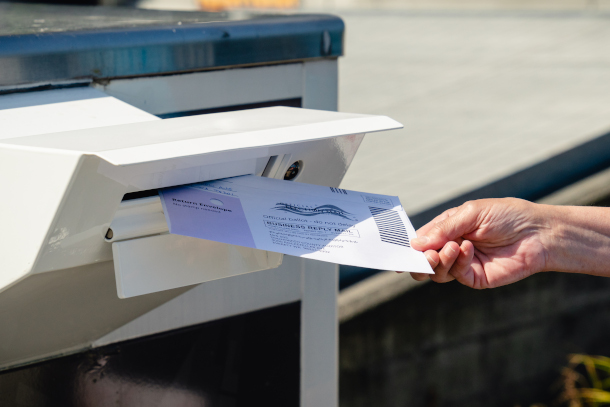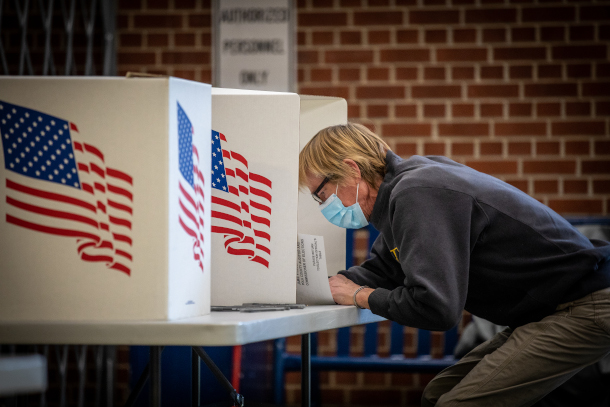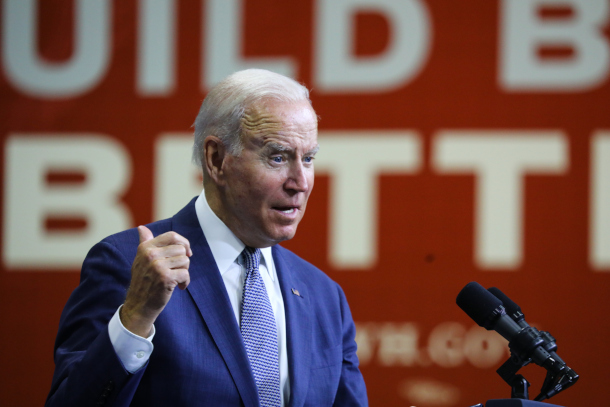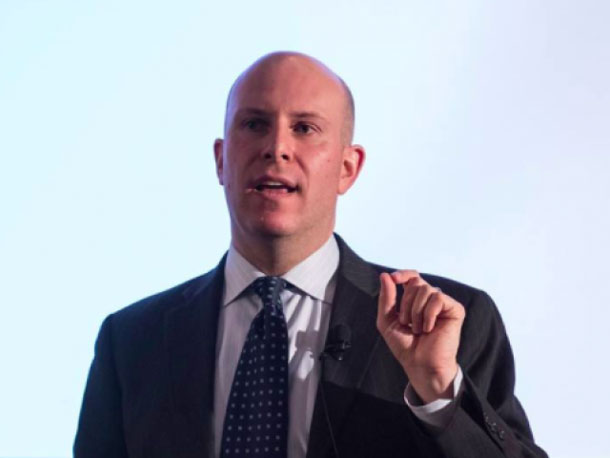Green Voter Opportunity
Air Date: Week of February 18, 2022

Almost 1 million environment-first voters cast a ballot in the 2020 election, but have never voted in a midterm election. (Photo: Cindy Shebley, Flickr, CC BY 2.0)
The Environmental Voter Project has spent years identifying registered environment-first voters and motivating participation. Their recent research found nearly 1 million environmentalists who voted in the 2020 presidential election but have never voted in a midterm election. Nathaniel Stinnett, founder and executive director of the Environmental Voter Project joins Host Steve Curwood to talk about why these so-called environmental drop-off voters could be decisive in the 2022 midterms if they show up at the polls.
Transcript
BASCOMB: From PRX and the Jennifer and Ted Stanley studios at the University of Massachusetts, Boston this is Living on Earth. I’m Bobby Bascomb.
CURWOOD: And I’m Steve Curwood.
To date the United States Congress has done nothing major to combat the growing dangers from climate disruption, though it came close in 2009 when the Waxman-Markey bill was passed by Democrats in the House but derailed in the Senate by the filibuster. And so far, along with Democratic caucus defections, the threat of a filibuster still looms large in the failure to take climate action by the present Congress. Political consultants say there are enough potential environmental activist voters who could shift the balance of power in Congress in the upcoming mid-term elections if they get out to vote, and those consultants include Nathaniel Stinnett. Nathaniel Stinnett is founder and executive director of the Environmental Voter Project, which looked at environmental voter data from eight battleground states. This research finds that nearly 1 million environmentalists who voted in the 2020 presidential election have never voted in a midterm election. He joins me now to explain how these so-called environmental drop-off voters might make an impact this fall. Welcome back to Living on Earth, Nathaniel!
STINNETT: Thank you so much, Steve. I always love chatting with you.
CURWOOD: As do I. Now, remind us, how does the Environmental Voter Project define an environmental drop-off voter?
STINNETT: So these are voters who in our targeting research show up is having a really high likelihood of not just caring about climate or the environment, but literally listing it as their number one priority. But we see from public voter files that they vote in presidential elections, but not in midterms. So that's where that term drop-off comes from. And as you can imagine, these are important mobilization targets for campaigns, because they may not be great voters, but they at least have some history of voting. They're the closest to being pulled off the sidelines.
CURWOOD: Nathaniel, let's talk about the states that you looked at here.
STINNETT: Yeah, so we studied eight states, so Arizona, Nevada, Texas, Florida, Georgia, North Carolina, Pennsylvania, New Hampshire, for two reasons. First, they have huge populations of non-voting, and infrequently-voting environmentalists. So these are the states where the climate and environmental movements have a lot of untapped political power. And then the second reason is, they're all midterm battleground states. So each of these eight states has a combination of important and competitive Senate races, and Gubernatorial races and House races. So we knew this data would be both timely and important in 2022. These are important states, where infrequent environmental voters can make a really, really big difference if we show up.
CURWOOD: So now, what are the demographics of these environmental drop-off voters? How do they compare to overall environmental voters and voters in general?
STINNETT: So, they're very similar to overall environmental voters. So the difference between these drop-off voters and other environmental voters isn't that different. But when we look at how they compare to the overall electorate, these environmental drop-off voters are younger, they're more likely to be women than men. And they're more likely to be people of color than white, with especially large groups of Hispanics and Asian Americans. So to give you an example, let's look at Pennsylvania. So, Pennsylvania is one of the states that we studied. In Pennsylvania, women outnumber men among these drop off voters by 18 percentage points. Asian Americans make up 3.8% of these environmental drop off voters. And that might not sound like a lot. But Asian Americans are only 1% of the overall population in Pennsylvania. So they're almost four times as prevalent among these environmental drop off voters as they are in the whole electorate.

The Environmental Voter Project identified several battleground states with potential for environmentalists to make decisive change with their voting power. (Photo: Phil Roeder, Flickr, CC BY 2.0)
CURWOOD: What are some of the numbers? Let's keep talking about Pennsylvania. How many voters there that will make a difference in the midterm elections? And how do the environmental drop-off voter numbers compare to the key margins in those races?
STINNETT: Yeah, so that's a great question. So first, let me give you some context. In Pennsylvania, if we go back to the last midterm election in 2018, a little over 5 million ballots were cast. We have identified 185,000 of these environment-first drop-off voters. So that's a pretty pretty big number, even out of the 5 million ballots that were cast. But let me give you some more context, because we all know that Pennsylvania is an important state, and boy are the margins tight there. So let's look at 2020 and 2016. In 2016, Donald Trump won Pennsylvania by 44,000 votes. In 2020, Joe Biden won it by 80,000 votes. So the fact that there are 185,000 of the super environmentalists who vote in presidentials, but not midterms, is really, really important. I mean, this is a huge pool of latent political power for the environmental movement in a really important state.
CURWOOD: Now, in the 2020 elections, certainly the numbers of people that your environmental voter projects encouraged to get out. Those numbers were larger than the margins by which the Senate races and for that matter, the Presidential race was decided there. So which states now do you find most intriguing for these midterm elections?
STINNETT: So a lot of the states that we we studied, Steve, have huge numbers of these infrequent environmental voters, particularly Pennsylvania, Arizona, New Hampshire. But the state I am totally obsessed with during these midterms, Steve is Nevada. Nevada, has over 56,000 of these environmental drop off voters, which would be a big number in any state but in Nevada, that's truly enormous. So for context, 975,000 people cast ballots in the 2018 midterms in Nevada. So what that means is these environmental drop off voters are equal to almost 6% of all ballots cast in Nevada's last midterm. So that's a huge pool of potential political power. And then when you combine that with the fact that Nevada is going to have a competitive gubernatorial election, a competitive US Senate election, and three out of their four House districts are going to be competitive. Well, that means these Nevada environmentalists won't just impact the future of their own state, they could very easily determine all our futures, they could determine the Senate, they could determine the House, they could determine so so much. So I encourage everybody out there: don't sleep on Nevada this year, it's going to be a crucially important state.
Help us turn 1 million environmentalists from presidential voters into midterm voters. https://t.co/DqwFqXhfjy #ClimateActionNow #ClimateAction #ActOnClimate
— Environmental Voter Project (@Enviro_Voter) January 28, 2022
CURWOOD: And Nevada is relatively closely divided, right? It's not particularly red, it's not particularly blue, but purple, is the way some of you political folks refer to it.
STINNETT: That's exactly right. It is absolutely a purple state. All of those competitive races that I just mentioned, are really, really close. Now, obviously, we're nine months out and polls change, but they're very, very close. And so yeah, this is one of the most purple of purple states. And it often gets overlooked for the Georgias and Arizonas and Pennsylvanias of the world. But Nevada is razor razor thin, these margins.
CURWOOD: So Nathaniel, talk to me about Arizona, what's going on there? We've seen a supposedly Democratic senator hold out against the President for what could have would have been climate action. And there's a Senate race there for the other seat for the chap who just finished out a term.
STINNETT: Yeah, Arizona is so important. And it's also such a huge opportunity for the environmental movement in 2022. And here's what I mean by that. First, there's a competitive Senate race, a competitive gubernatorial and at least four maybe more competitive House seats. The second reason is there are over 101,000 of these environmental drop-off voters that we've identified in Arizona. That is a number so large that it equals 4.3% of all ballots that were cast in the 2018 midterms. So that's a big, big pool of potential political power. And then the third thing I'll say about Arizona is this is a state where the presidential election was decided by a little more than 10,000 votes. I mean, that's nothing. That is nothing. I mean, a butterfly flaps its wings in the Sonoran Desert, and that eventually can impact more than 10,000 votes. I mean, 10,000 votes is nothing in politics. And so the fact that we've identified 101,000, environmental drop off voters in the state is a huge, huge opportunity for us. Arizona has tons of local elections this winter and spring, they then have their primary, they then often have special elections. And so we're going to get multiple bites at the apple, multiple opportunities to talk to these environmental drop off voters before November comes around. And so it is such a great opportunity for us, if we can only get five or 10% of these drop off voters to show up. That's the margin of the entire presidential election in Arizona. That can be a big, big deal.

After Congress failed to pass the environment-forward Build Back Better bill, many environmental activists say they feel discouraged. (Photo: Edwin J. Torres, New Jersey Governor’s office, Flickr, CC BY-NC 2.0)
CURWOOD: Nathaniel, to what extent are climate and environmental voters deflated or upset by, say, the major losses like the Build Back Better Plan that was supposed to deliver on the climate in such a big way?
STINNETT: Well, there's no doubt that the underlying premise of your question, Steve is true. Climate voters are demanding more. And a recent political poll even said that 80% of left-leaning voters think Biden has done too little to combat climate change. But if we truly want more climate leadership, we need to be honest with ourselves about why we're not getting it right now. And the hard truth is that the environmental movement simply doesn't have enough political power right now to pressure senators and governors and mayors and yes, presidents into leading on climate. And it's kind of wishful thinking to assume that politicians will ever combat climate change unless voters start forcing them to. I mean, these are political animals, and the only thing that moves politicians is political power. So we need more of it. Even when we're frustrated by politics, we need to get stronger and exercise more voting power on election day, not less, because ultimately, the climate crisis doesn't care whether we're conflicted or unhappy on election day. But if we stay home, and environmentalists don't vote then things are going to get a whole lot worse really quickly.
CURWOOD: So how do you get these people to vote?

Nathaniel Stinnett serves as Founder and Executive Director of the Environmental Voter Project. (Photo: Courtesy of the Environmental Voter Project)
STINNETT: Well, usually, oddly enough, we don't treat them as rational beings, we don't try to try to rationally convince them of the importance of their one vote. Usually, we treat them as social beings, we try to figure out what societal norms they buy into, who they want to be. And so we use things like peer pressure. We'll send them a message and let them know how many of their neighbors voted last time there was an election, things like that. And then in particular, for these drop-off voters and this report that we just released, Steve, we can use a really, really special technique with these drop-off voters, a phenomenon known as loss aversion, which is the idea that people usually fear losing something more than they appreciate gaining it. So what do I mean by that in this instance? Well, our messaging thanks these environmentalists for voting in 2020, and then says stuff like: don't break your streak! Don't mess up your new good voting record! And that way, instead of making voting in the midterm seemed like a new hard step that they need to take, we're characterizing it as a way to retain or not lose an already existing part of their personality, which is being a voter. And that works really, really well. Taking advantage of that loss aversion can dramatically boost turnout, because we're making voting seem like something they've already got. And it's important not to lose it.
CURWOOD: Nathaniel Stinnett is the founder and executive director of the Environmental Voter Project. Nathaniel, thanks so much for taking your time with us today.
STINNETT: Thank you so much for having me, Steve. I always really enjoy it.
Links
Learn more about the Environmental Voter Project
Read the Environmental Voter Project’s report
Listen to LOE’s most recent segment with Nathaniel Stinnett about 2021’s Georgia run-off elections
Living on Earth wants to hear from you!
Living on Earth
62 Calef Highway, Suite 212
Lee, NH 03861
Telephone: 617-287-4121
E-mail: comments@loe.org
Newsletter [Click here]
Donate to Living on Earth!
Living on Earth is an independent media program and relies entirely on contributions from listeners and institutions supporting public service. Please donate now to preserve an independent environmental voice.
NewsletterLiving on Earth offers a weekly delivery of the show's rundown to your mailbox. Sign up for our newsletter today!
 Sailors For The Sea: Be the change you want to sea.
Sailors For The Sea: Be the change you want to sea.
 The Grantham Foundation for the Protection of the Environment: Committed to protecting and improving the health of the global environment.
The Grantham Foundation for the Protection of the Environment: Committed to protecting and improving the health of the global environment.
 Contribute to Living on Earth and receive, as our gift to you, an archival print of one of Mark Seth Lender's extraordinary wildlife photographs. Follow the link to see Mark's current collection of photographs.
Contribute to Living on Earth and receive, as our gift to you, an archival print of one of Mark Seth Lender's extraordinary wildlife photographs. Follow the link to see Mark's current collection of photographs.
 Buy a signed copy of Mark Seth Lender's book Smeagull the Seagull & support Living on Earth
Buy a signed copy of Mark Seth Lender's book Smeagull the Seagull & support Living on Earth

